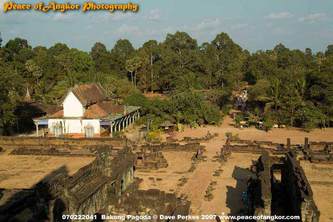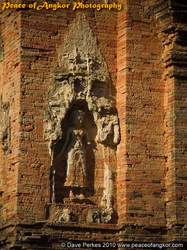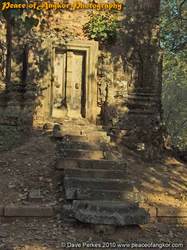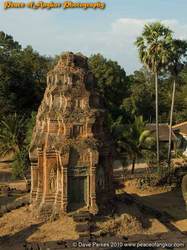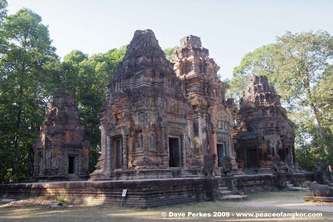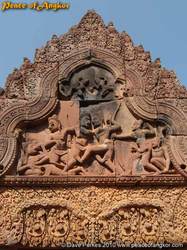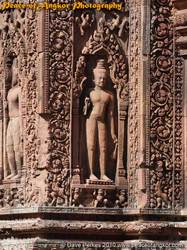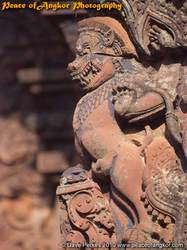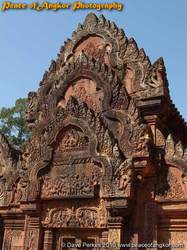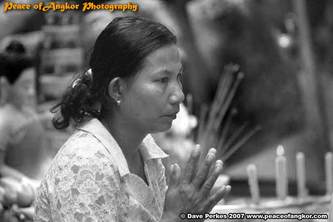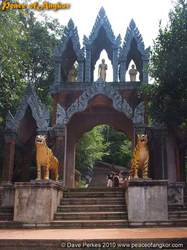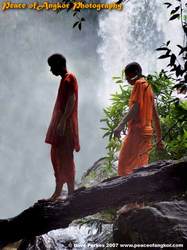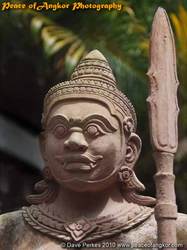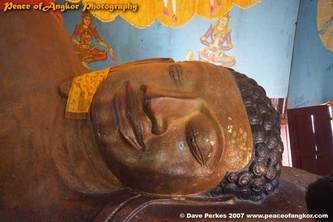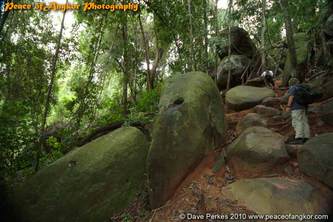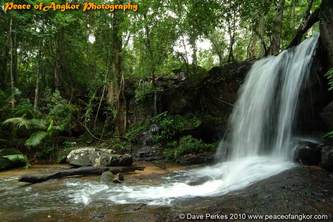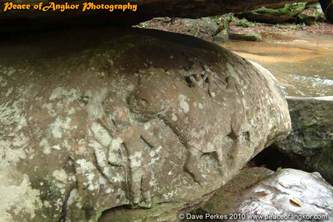PEACE OF ANGKOR PHOTOGRAPHY
THE SIGHTS THAT SURROUND ANGKOR

Banteay Srey
The Province of Siem Reap has hundreds of archeological sites that lie within the Angkor park and many outside. Some sites like Banteay Srey Kbal Spean and Roluos group are within Angkor Park so are justifiably very popular.
Others like Chau Say Vibol, Wat Attvea, Phnom Bok and Kulen Mountain are less visited by tourists; yet are of interest for those withing to get off the beaten path.
Others like Chau Say Vibol, Wat Attvea, Phnom Bok and Kulen Mountain are less visited by tourists; yet are of interest for those withing to get off the beaten path.
Roulos Group

Bakong Pyramid with lotus flower tower
Situated to the East of the Angkor Park the Roluos group of temples were one of the earliest of the Khmer Capital cities. The Bakong, pictured above, is a highly significant pre-Angkorian site; built in the 9th century by King Indravarman I
The temple surrounded by a moat has a five stepped pyramid with a lotus flower tower at its summit. This tower was an addition built in the 12 the century. in Angkor Wat style.
Two other temple sites: Preah Ko and Lolei were built at the same time. Preah Ko, the temple of the Sacred bull, consists of three brick towers with a Nandi or Sacred Bull sculpture in front. The brick towers have impressive lintels, Apsaras and the remains of some the original decorative stucco .
The temple surrounded by a moat has a five stepped pyramid with a lotus flower tower at its summit. This tower was an addition built in the 12 the century. in Angkor Wat style.
Two other temple sites: Preah Ko and Lolei were built at the same time. Preah Ko, the temple of the Sacred bull, consists of three brick towers with a Nandi or Sacred Bull sculpture in front. The brick towers have impressive lintels, Apsaras and the remains of some the original decorative stucco .
Banteay Srey

Banteay Srey Causeway
A favorite of whoever visits it; this small Hindu temple of Banteay Srey has the finest of all the carvings of the temples of Angkor. It is made of rare pink sandstone; which the source is unknown. The carvings and reliefs have a unique three dimensionality about them. The stone used is incredibly fine grained; which allowed the artisans to create a masterpiece.
The temple is surrounded by laterite walls; with a causeway and moat that leads to the central Sanctuary. Within the sanctuary are a number of diminutive buildings and shrines. All have low doorways and tiny windows giving the impression that this is a temple in miniature. The central sanctuary has been off limits for several years to protect the delicate stonework.
Banteay Srey is popular with tour groups taking advantage of the morning light. You have to get there early; to avoid the crowds!
The temple is surrounded by laterite walls; with a causeway and moat that leads to the central Sanctuary. Within the sanctuary are a number of diminutive buildings and shrines. All have low doorways and tiny windows giving the impression that this is a temple in miniature. The central sanctuary has been off limits for several years to protect the delicate stonework.
Banteay Srey is popular with tour groups taking advantage of the morning light. You have to get there early; to avoid the crowds!

For more information on our tours to Rouos and Banteay Srey
Kulen Mountain

Phnom Kulen watefalls
This is the most sacred of all Khmer Pilgrimage sites situated in a picturesque location just over 1 hour drive from Siem Reap. Approached by a scenic mountain road it gives some of the best landscape views in the Area. The falls are a popular bathing place for local families. At festival times the Wats and Reclining Buddha are a place of great atmosphere. There is an area of Hindu Lingas on the riverbed; though nothing as extensive as Kbal Spean.
Above the falls there are a number of temple sites and carved animal figures scattered around on the top of the hill.The upper falls are easy to see and are used for bathingl. The Water thunders over the edge down a couple of steps to the main falls which are spectacular.
Above the falls there are a number of temple sites and carved animal figures scattered around on the top of the hill.The upper falls are easy to see and are used for bathingl. The Water thunders over the edge down a couple of steps to the main falls which are spectacular.

For more information on our tours to Kulen Mountain ***
Kbal Spean - the Valley of a Thousand Lingas

Kbal Spean lingas
Kbal Spean is an ancient Hindu pilgrimage site in the jungle on the south side of Kulen Mountain. It is commonly known as the valley of a 1000 Lingas; due to the presence of the over a thousand lingas. The lingas in Kbal Spean were carved in the riverbed between the 11th and 13 centuries. They were believed to fertilize the water of the Siem Reap River. These Hindu phallic symbols are often represented standing on the Yoni or womb. They are always oriented with the drainage channel of the Yoni facing north. At Kbal Spean, the lingas are aligned to the compass; with some arranged in groups of 5; representing the 5 peaks of the mythical mount Meru.
The waterfall here is best seen at the end of the rainy season.
The waterfall here is best seen at the end of the rainy season.

For more information on our tours to Kbal Spean ***
The Barays and Resrvoirs of Angkor
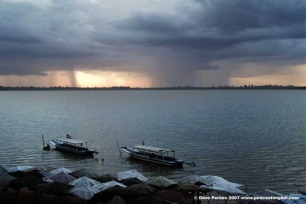
Western Baray prior to a storm
The Ancient Khmer built a network of irrigation channels, causeways and reservoirs. Much of the system is still used today.The vast Western Baray was the largest of all. At 8.5 kms by 2.25 kms ; this immense reservoir was contained within earth banks and is filled solely by rainwater. Although built 800 years ago; the reservoir still contains most of its water.
The small temple at the centre can be reached by boat from a small resort accessed by road 3 kms west of the Siem Reap Airport. The best view of the Baray can be seen from Phnom Bakheng or the Angkor balloon which flies daily 2kms west of Angkor Wat.
The slightly smaller East Baray extends for 7.5 kms x 1.75kms; but dried up centuries ago. At its centre lies the splendid brick built East Mebon temple. It has 5 towers in a three tiered pyramid representing the mythical Mount Meru.
The dried up reservoir that surrounded it, is now a rich farmland area centered on the village of Pre Dak. The villagers exploit the tourist trade by selling souvenirs and basket work at almost all the roadside houses. Those who travel from Pre Dak to Banteay Srey temple can see the line of trees and the northern earth bank 1 km north of the village.
The small temple at the centre can be reached by boat from a small resort accessed by road 3 kms west of the Siem Reap Airport. The best view of the Baray can be seen from Phnom Bakheng or the Angkor balloon which flies daily 2kms west of Angkor Wat.
The slightly smaller East Baray extends for 7.5 kms x 1.75kms; but dried up centuries ago. At its centre lies the splendid brick built East Mebon temple. It has 5 towers in a three tiered pyramid representing the mythical Mount Meru.
The dried up reservoir that surrounded it, is now a rich farmland area centered on the village of Pre Dak. The villagers exploit the tourist trade by selling souvenirs and basket work at almost all the roadside houses. Those who travel from Pre Dak to Banteay Srey temple can see the line of trees and the northern earth bank 1 km north of the village.
Phnom Krom

Phnom Krom and Boat port at high water
The hill by the Boat port at Chong Khneas is a great viewpoit to see the Tonle Sap Lake. In the Flood Season the hill becomes a virtual island with causeways linking the northern part of Chong Kneas to the mainland. The ruined towers of Prasat Krom are in poor condtion and not of much interest; however an Angkor Pass is needed for this site.
From August to December its a great place for sunset.
Outside of these dates the water of the Tonle Sap can be up to several kilometres away and when its hazy the lake is hard to see.
From August to December its a great place for sunset.
Outside of these dates the water of the Tonle Sap can be up to several kilometres away and when its hazy the lake is hard to see.
Wat Attvea

Wat Attvea
This small Angkor Wat style temple is situated a few kilometres south of Siem Reap on the road to the Chong Khneas boat port. its worth the detour if you are passing as it it very tranquil here with few tourists.

Peace of Angkor Tours is western owned and operating photo and adventure tours in Cambodia since 2003.
Our Comprehensive Peace Of Angkor Tours website gives general information, full tour details and reservation by credit card,
Head Office: Peace Of Angkor Tours # 435 Street 20 Wat Bo, Siem Reap, Cambodia
+855 (0)63 760 475 (office) +855 (0)77 230 642 (SMS) mobile +855 (0)12 448 170 mobile, Email [email protected]
Our Comprehensive Peace Of Angkor Tours website gives general information, full tour details and reservation by credit card,
Head Office: Peace Of Angkor Tours # 435 Street 20 Wat Bo, Siem Reap, Cambodia
+855 (0)63 760 475 (office) +855 (0)77 230 642 (SMS) mobile +855 (0)12 448 170 mobile, Email [email protected]
